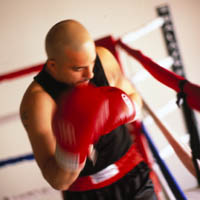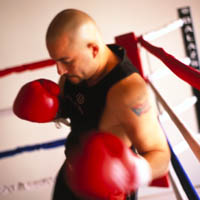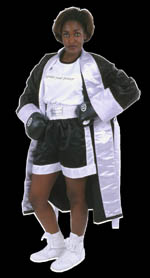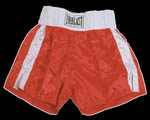


A Quick History Lesson
Boxing has come a long way since the days of bare-knuckle fighting. Now considered the “sweet science,” boxing has taken on a whole new form.
During the days of bare-knuckle boxing (in the 19th century), competitors had to be extremely accurate with their punches. One wrong move and they could wind up severely damaging their hands. Boxers of this era relied on defending themselves—blocking, slipping, countering, and wrestling. The action of a fight tended to be slower paced with a lot of luring and drawing tactics. Boxers fought 20, 45, and even 75 round matches, and had to be conservative with their punches. They would pick their openings and fight in two and three punch bursts over the course of a fight.
With the introduction of gloved boxing in 1892, boxing made its first step toward modernization, although styles didn’t change right away. In general, boxers threw only two or three punches at a time. Parrying and countering were the fundamentals of boxing technique at the turn of the century.
Advances in footwork and defense began during the early 1900s. With the hands better protected, a boxer did not have to fight so defensively, or be so cautious. Eventually boxers learned that skill could overcome a superior punch. By the 1920s, combination punching had become universal. Most of the best techniques were in place by this time, and only minor innovations occurred throughout the rest of the century.
Today, boxing is divided into amateur and professional. Overwhelmingly, boxers start as amateurs and later become professional boxers. The rules in each division are quite different. We have outlined these differences below.
Amateur Boxing vs. Professional Boxing
OBJECTIVE
Land punches. The force of a strike or its effect on the opponent does not count.
A strike that knocks a boxer to the mat receives no more credit than any other strike. A knockdown is scored as a single blow and does not necessarily make the boxer a winner of that round.
OBJECTIVE
Score points. Points are awarded based on a strike’s impact and effect on the opponent. Judges award points based on a fighter’s aggressiveness and technique. The knockdown or knockout is an objective in the pros. In rare cases, a fighter who scores a knockdown may lose the round.
ORGANIZATION
Amateur boxing is under the jurisdiction of a single national governing body. USA Boxing, for example, has jurisdiction over the administration and rules of competition for amateur boxing in the United States.
ORGANIZATION
No single governing body exists. Many state-controlled commissions have different sets of rules and guidelines.
INTERNATIONAL REGULATIONS
Amateur boxing uses the same set of rules worldwide. USA Boxing�s rules comply with the international regulations. However, USA Boxing has more stringent safety guidelines.
ORGANIZATION
There are various sanctioning bodies which all have their own set rules.
GLOVES
USA Boxing requires 10-ounce gloves for 106-156 Lb. boxers, 12-ounce gloves for 165 to 201+ Lb. boxers. Gloves used in the US must have the USA Boxing label.
All AIBA gloves are 10 ounce in weight, and must have the AIBA label. White area denotes striking surface�this aids judges in scoring. Must be thumb-attached or thumbless.
Gloves are specially designed to absorb shock.
ORGANIZATION
8 and 10 oz. gloves, depending on jurisdiction.
No striking surface is indicated.
Gloves are designed to transmit force.
HEADGEARS
Headgears are mandatory in the U.S. and in major international competitions
ORGANIZATION
Headgears are prohibited.
FOULS
A strike counts for scoring only if the knuckle surface is used; slapping, etc., is not allowed nor does it count for points.
The striking area is limited to the front and side of the head and body, above the waist.
Fouls (unfair or dangerous tactics, hitting outside of the striking area) lead to warnings and point penalties. Disqualification after 3 warnings.
FOULS
Fighters are warned only if they have performed a harmful foul (below the belt, etc).
STANDING EIGHT COUNT
Given to a boxer in difficulty, standing eight counts allow the referee to evaluate the condition of a boxer. For men, the bout is stopped after 3 eight-counts in a round or 4 in total. The compulsory count limit for females is one less than men.
STANDING EIGHT COUNT
Usually do not exist in professional boxing.
OUT-CLASSED
Referee will stop the bout if a boxer is out-classed.
OUT-CLASSED
Referee is authorized to stop the fight. Due to financial and TV arrangements however, fights are rarely stopped.
PHYSICAL
Physicals are mandatory before and after a bout. In a tournament, the boxer has an initial physical and then before and after each bout for each day of competition.
PHYSICAL
Professional physicals range from cursory to substantial before the fight, depending on the state requirements. Typically no physical takes place after the fight, unless a fighter obviously needs medical attention.
ATTIRE
Tops are mandatory for males and females. They assist the judges in identifying the boxers. Tops also absorb sweat, blood and dirt.
ATTIRE
Tops are prohibited for males. Female pro fighters usually only box in a sports bra-type top (not a singlet).
VASELINE/GREASE
Prohibited.
VASELINE/GREASE
Permitted.
ROUNDS
Four 2-minute rounds with 1-minute break in between for Open Division males; three 2-minute rounds for women. Shorter rounds for novices and boxers under 17.
ROUNDS
Vary considerably. From four rounds of 3 minutes up to twelve rounds of 3 minutes.
If you would like information on how to become an amateur or professional boxer, email us at info@BoxingSource.com
Gear up for Fight Season!
To get you ready for fight season, Balazs is offering
40% off ALL in-stock Everlast ring apparel!
Not a competitive boxer? Boxing robes and trunks
make great Halloween costumes!
 Everlast Satin Robe
Everlast Satin Robe
Full Length and 3/4 Length satin boxing robes.

 Satin Boxing Trunks
Satin Boxing Trunks
Full-cut legs for kickboxing as well as boxing. Satin shorts have three-inch wide elastic waistband for comfortable fit.
 Everlast Boxing Shoes
Everlast Boxing Shoes
Padded innersole with cushioned arch support and built-in wedge under the heel. Top-grain cowhide upper with stretch nylon mesh. Foam padded tongue reinforced with woven nylon mesh.

We hope you enjoyed receiving this mailing. However, if you would not
like to be included in future Balazs Boxing mailings, please
respond to this email with "remove" in the subject line.
